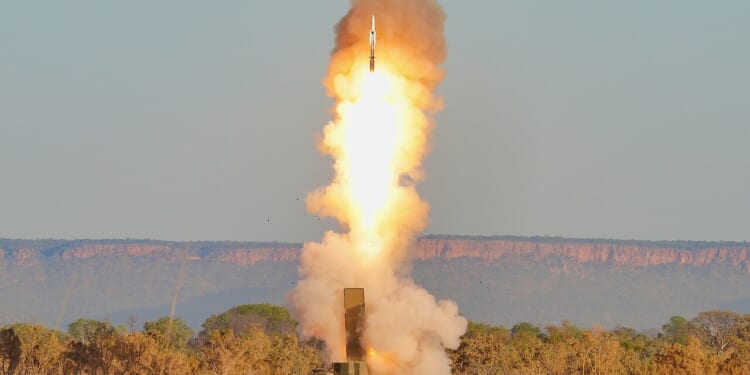This missiles’ placement has been met with predictable pearl-clutching from Chinese leaders, who previously had no compunctions about arming their manmade islands in the South China Sea.
In 2009, the People’s Republic of China (PRC) began an aggressive manmade island-building campaign in the international waters of the South China Sea (SCS). America and many of the neighboring Pacific nations cried foul—but Beijing was undeterred, and over the next decade, it solidified its military hold in the hub of one of the busiest waterways in the world.
Not only did China permanently project its military power into the SCS, but it was also able to extend their anti-access/area-denial (A2/AD) area far beyond their national borders. What’s more, Beijing was now in a position to disrupt key trading routes in the event of a conflict with the United States and its regional allies.
From there, China began bullying its neighbors, such as the Philippines, for control over what should have been Philippine territory in the SCS. It did the same to the other nations of the SCS, too. In 2016, after a Philippine complaint, an international arbitration panel determined that China had violated international maritime law, based on a unanimous international consensus on the United Nations Convention of Law of the Sea (UNCLOS)—but Beijing refused to recognize the validity of the ruling.
Following its success in the SCS, China started becoming similarly aggressive with their great regional rival, Japan, in the East China Sea (ECS). After more than a decade of basically taking it on the chin, the Americans and their regional partners are making moves to finally check China’s ambitions throughout the wider region. One hopes that it is not too little, too late.
America’s New Missiles in Japan Can Hit China
The recent US decision to station a Typhon Mid-Range (MRC) missile system in Japan for the first time represents a significant shift in US policy in the Indo-Pacific.
This policy shift has been met with predictable pearl-clutching from China’s leaders—the same leaders, of course, who had no problem impinging on the territorial integrity of their neighbors and trampling on the freedom of navigation in key waterways like the SCS. China’s resident “wolf warrior” diplomat-in-chief, Foreign Ministry Spokesman Lin Jian, howled at the international press assembled in Beijing that the deployment of the MRC system to Japan “undermines the legitimate security interests of other countries, fuels the risk of a regional arms race and military confrontation, and poses a substantial threat to regional strategic security.”
Sure, Lin Jian.
The MRC has been deployed to Japan as part of a joint military exercise between the US military and the Japanese Self-Defense Force. That exercise is called “Resolute Dragon”, and the MRC is being placed at the US Marine Corps base Iwakuni in Western Japan. The system, which can launch Tomahawk cruise missiles and SM-6 surface-to-air missiles with ranges exceeding 1,000 miles, was described as a temporary drill.
But Beijing understands that, with the US government, things that are temporary often have a way of becoming permanent. Of course, the exact same thing could be said of the Chinese manmade islands in the SCS. Indeed, the deployment of the MRC to Japan follows a very similar move by Uncle Sam to the Philippines in 2024, which enraged Beijing.
The fact that the Americans are moving this system to Japan, however, is an especially irritating decision from China’s perspective, seeing as the Chinese regime loathes the Japanese government.
There is, of course, another perhaps understandable source of anger from China’s perspective. By placing the MRC in Japan, given that system’s range, the MRC can now reliably reach sensitive targets within China—including military assets and population centers along China’s crowded eastern seaboard.
China views this as a significant strategic threat and a serious escalation by Washington.
Not only that, but the deployment of the MRC system to Japan drastically complicates Chinese military planning for potential fights with the US and its regional partners over Taiwan and the SCS by expanding the scope and reach of US weapons deep inside mainland China.
Was This Why America Really Left the INF Treaty?
Interestingly, Chinese leaders believe that this move by the United States is part of a broader campaign to militarize the regions closest to China in the wake of the Trump administration’s consequential decision to withdraw from the Intermediate Range Nuclear Forces (INF) agreement in 2019. At the time, that move was widely understood as a response to Russia, the other party to the agreement, and the Kremlin responded with fury. In fact, Trump’s decision to pull out of the INF Treaty came about because China was not a signatory to that 1980s treaty—meaning that while the US and Russia limited their intermediate range ballistic missile forces, China had an open field to rapidly and unapologetically build their own capabilities to outstrip those of both the US and Russia.
Further, China has married their intense opposition to the deployment of the MRC with historical grievances over Japanese militarism in World War II. By making this argument, Beijing attempts to portray Tokyo as the continued aggressor against China, much as it was 80 years ago. Of course, Beijing’s framing completely overlooks its own period of aggression in the South and East China Seas, now well into its second decade. But, hey, who’s counting?
As for Washington, it is framing the move as a temporary and defensive measure aimed at countering the obvious threat that China and Russia are posing to US interests and allies in the Indo-Pacific.
Left unsaid is that the Americans are also seeking to apply pressure to Beijing in other areas, as China’s government takes increasingly hardline stances in the ongoing trade war between America and China. Unable to find leverage in the economic domain due to China’s disturbing grip on the world’s rare earth mineral resources, Washington is now shifting to pressuring China militarily.
Ultimately, regardless of the underlying reasons for Washington putting the MRC system in Japan, the fact remains that Beijing has spent more than a decade provoking its neighbors and running roughshod over the regional order. The United States is justified in putting the MRC system in Japan.
About the Author: Brandon J. Weichert
Brandon J. Weichert is a senior national security editor at The National Interest. Recently, Weichert became the host of The National Security Hour on America Outloud News and iHeartRadio, where he discusses national security policy every Wednesday at 8pm Eastern. He is also a contributor at Popular Mechanics and has consulted regularly with various government institutions and private organizations on geopolitical issues. Weichert’s writings have appeared in multiple publications, including The Washington Times, National Review, The American Spectator, MSN, The Asia Times, and others. His books include Winning Space: How America Remains a Superpower, Biohacked: China’s Race to Control Life, and The Shadow War: Iran’s Quest for Supremacy. His newest book, A Disaster of Our Own Making: How the West Lost Ukraine is available for purchase wherever books are sold. He can be followed via Twitter @WeTheBrandon.
Image: Wikimedia Commons.

















